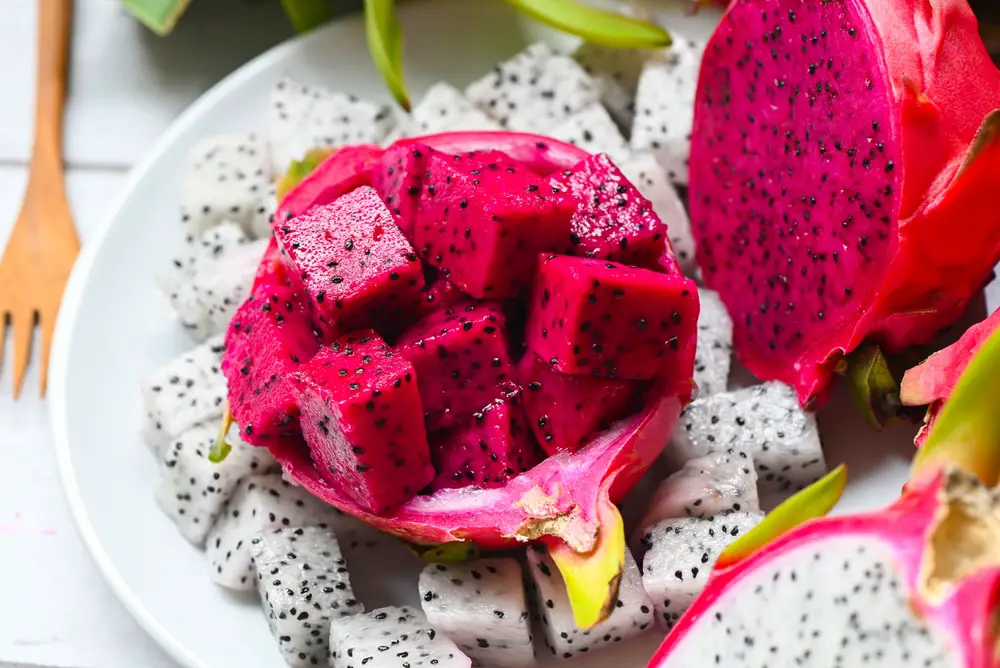Dragon fruit, also known as pitaya, is a tropical fruit that has been gaining popularity in recent years due to its unique appearance and potential health benefits. Originating in Central America, the fruit is now commonly found in Asian countries and has made its way to the US and European markets as well.
It is low in calories, packed with essential vitamins and minerals, and contains a substantial amount of dietary fibre, making it a nutritious addition to one’s diet.
Often, individuals may find themselves intrigued by the vibrant colours and exotic appearance of a dragon fruit but unsure of how to eat or prepare it. This article will offer guidance and tips on different ways to consume and enjoy the fruit.
The objective is to help readers understand the proper methods of preparing and incorporating dragon fruit into their culinary repertoire, as well as appreciating the various health benefits associated with the consumption of this tropical delight.
Consuming dragon fruit can be a simple yet enjoyable experience. With its mildly sweet flavour and pleasant texture, it can be easily incorporated into various dishes and snacks, such as smoothies, salads, or eaten on its own with a spoon. Stay tuned to learn helpful tips and techniques for making the most of this beautifully exotic and nutritious fruit.
Identifying and Selecting Dragon Fruit
Dragon fruit, also known as pitaya or strawberry pear, is a tropical fruit native to Central America and Southeast Asia. It belongs to the cactus family and comes in two main varieties: one with bright pink skin and the other with yellow skin. When selecting a dragon fruit, it is crucial to be able to identify ripe and ready-to-eat ones.
Examine the outer skin of the fruit, which can range from bright pink to deep golden in colour. Look for an evenly coloured skin, devoid of bruises and knife marks. Some variation in the skin is normal, but in general, it should be the same colour all over. Splotchy skin could be a sign that the fruit is overripe.
Another way to determine the ripeness of a dragon fruit is to gently press the surface. A ripe fruit should feel slightly soft, similar to a ripe pear. It should not be too hard nor too mushy, as both indicate a fruit that is either unripe or overripe, respectively.
Dragon fruit, like many other tropical fruits such as pineapple and mango, is a rich source of nutrients. It contains fiber, vitamins, and minerals such as iron and magnesium, providing numerous health benefits. Dragon fruit is also packed with antioxidants that help fight off free radicals, reducing inflammation, and possibly preventing cancer and other diseases.
Once you have successfully selected a ripe dragon fruit, it can be prepared and consumed in various ways. For instance, you can cut it open, remove the flesh, and scoop it out using a spoon or melon baller. Just be sure to use a sharp knife and a cutting board to minimise the risk of harmful bacteria on kitchen surfaces.
Dragon fruit can be enjoyed on its own, mixed into fruit salads with other berries and tropical fruits, or used as an ingredient in smoothie recipes. To create a delicious smoothie, combine dragon fruit with Greek yogurt, banana, and a splash of nut milk or coconut water, then blend until smooth.
When storing dragon fruit, ensure it is kept in a plastic bag or airtight container. Place it in the fridge if it is ripe and ready to eat, but if it is still slightly underripe, store it at room temperature until it softens. Proper storage will help to preserve the freshness and nutrients of the fruit.
In summary, identifying and selecting a ripe dragon fruit is essential to enjoying its unique flavour and numerous health benefits. Once you have found the perfect fruit, there is a wide variety of recipes and preparation options to enjoy this versatile tropical fruit.
How to Properly Cut and Peel Dragon Fruit
Using a Sharp Knife
To cut and peel a dragon fruit using a sharp knife, start by placing the fruit on a clean cutting board. Make sure it doesn’t roll around. Hold the fruit firmly in place while you use the knife to slice off both ends of the dragon fruit. Next, cut the fruit in half lengthwise, being careful not to crush the pulp inside.
Using the tip of the knife, carefully insert it just under the skin, following the curve of the fruit. Work your way around the entire edge, gently separating the flesh from the skin. Then, use your fingers to peel the skin away from the fruit. Finally, cut the peeled fruit into slices or cubes, and it’s ready to eat.
Using a Melon Baller
Another method to prepare dragon fruit is by using a melon baller. First, cut the dragon fruit in half lengthwise. Hold the fruit half firmly in your hand, and use the melon baller to scoop out small, round pieces of fruit from the flesh. Be careful not to scoop too deep, as you want to avoid including any skin.
Repeat this process with the other half of the dragon fruit. This method gives you bite-sized, visually appealing balls that are perfect for fruit salads or desserts.
Using a Spoon
If you don’t have a sharp knife or a melon baller, using a spoon is a simple and convenient option. Start by cutting the dragon fruit in half lengthwise. Then, hold one half of the fruit in your hand or place it on a stable surface. Using a spoon, gently scoop the flesh away from the skin in a single motion, working your way around the edge of the fruit half. Make sure to keep the spoon close to the skin to avoid leaving any fruit behind. Once you’ve removed all the fruit, you can dice or slice it as desired. Repeat this process with the other half, and your dragon fruit is ready to enjoy.
Consumption Methods
Eating Dragon Fruit Raw
Dragon fruit can be enjoyed simply by being consumed raw. To eat it raw, first, choose a ripe dragon fruit with bright red or pink skin. Slice the fruit in half and either use a spoon to scoop out the white or red flesh with tiny black seeds or peel off the skin and cut the flesh into bite-sized pieces.
The texture is similar to kiwi, and can be consumed on its own or added to fruit salads, yoghurt, or as a topping for your breakfast cereal.
Preparing Smoothies and Juices
A popular way to consume dragon fruit is by blending it into smoothies or juices. Adding chunks of dragon fruit to a strawberry coconut milk smoothie not only enhances the flavour but also provides additional nutrients, like vitamins and minerals.
You can also combine dragon fruit with other fruits and vegetables for a refreshing and nutritious drink, such as mixing it with pineapple and spinach in a green smoothie.
Dragon Fruit Salads and Salsas
Incorporating dragon fruit into salads or salsas is another excellent way to enjoy this exotic fruit. You can create a colourful and delicious fruit salad by mixing cubes of dragon fruit with other tropical fruits, like mango, pineapple, and papaya. Add a splash of lime juice to bring out the flavours and create a refreshing, healthy dish.
Alternatively, you can create a unique, flavourful salsa by combining diced dragon fruit, red onion, jalapeño, cilantro, and lime juice. This salsa pairs well with dishes like grilled chicken, fish, or tacos.
Frozen Treats and Desserts
Dragon fruit can be a delightful ingredient for frozen treats and desserts. Simply freeze the flesh in chunks and toss them into a blender with other fruits like bananas or strawberries to create a delicious smoothie bowl or blended fruit sorbet.
Another option is to create a unique ice cream flavour by blending dragon fruit with coconut milk and a sweetener like honey or agave. Additionally, dragon fruit can be added to mousses, cheesecakes, and other desserts, offering a burst of colour and flavour to elevate your sweet treats.
Dragon Fruit Nutrition and Health Benefits
Dragon fruit is low in calories, but it is packed with essential vitamins and minerals such as vitamin C, vitamin A, calcium, and iron. In addition to being nutritious, dragon fruit is an excellent source of dietary fibre, which supports a healthy gut and improves digestion.
One of the key health benefits of dragon fruit comes from its rich antioxidant content. These antioxidants help neutralise free radicals in the body, which are harmful molecules that contribute to inflammation and chronic diseases like cancer. By protecting cells from oxidative damage and promoting a healthy immune system, antioxidants play a crucial role in reducing the risk of disease.
Dragon fruit is also known for its ability to support heart health. Regular consumption can reduce LDL (bad cholesterol) levels, increase HDL (good cholesterol) levels, and help control blood pressure. This, in turn, leads to a lower risk of heart disease and stroke.
Another noteworthy benefit of dragon fruit is its impact on blood sugar levels. The fibre in dragon fruit can help with blood sugar management by slowing down the absorption of sugars in the blood, which may be helpful for people with diabetes.
Furthermore, the presence of lycopene, a powerful antioxidant found in dragon fruits, is beneficial in reducing inflammation and preventing cell damage. Lycopene has been linked to a reduced risk of prostate, lung, and stomach cancers, as well as cardiovascular disease.
In summary, incorporating dragon fruit into your diet can provide numerous health benefits, such as improved gut health, boosted immunity, controlled cholesterol levels, better blood sugar management, and reduced inflammation. Due to its rich antioxidant content, dragon fruit also offers protection against various diseases, including cancer.
Storing and Preserving Dragon Fruit
When it comes to storing dragon fruit, proper handling and conditions are essential for maintaining its freshness and taste. A ripe dragon fruit will have a firm texture with a slight give, similar to an avocado. Knowing how to store this exotic fruit correctly will help prevent spoilage and ensure its deliciousness.
To store unripe dragon fruit at room temperature, simply keep it on the counter away from direct sunlight. The fruit will continue to ripen and should be ready to eat in a few days. However, it’s essential to avoid storing unripe dragon fruits in the fridge, as it will hinder the ripening process and may cause it to lose its flavour and texture.
If you plan to consume the ripe dragon fruit within a week or more, storing it in the fridge is the best option. The cooler temperature will slow down the ripening process and preserve its freshness. To store dragon fruit in the fridge, place it in a plastic bag with small air holes to allow for proper air circulation and to prevent excess moisture.
In case you have already cut the dragon fruit, it can be stored in the fridge for up to 48 hours. To maximise freshness, place the cut pieces in an airtight container or wrap them tightly with plastic wrap before refrigerating.
Whenever you’re ready to eat or use dragon fruit, simply remove it from the fridge and allow it to reach room temperature for the best flavour and texture. Storing and preserving dragon fruit correctly will ensure that you can enjoy this exotic, nutritious, and delicious fruit at its best.
Possible Side Effects and Allergies
Dragon fruit, although a delicious and nutritious choice, may cause allergic reactions in some individuals. It is generally safe to eat; however, few cases of allergic reactions have been reported. Symptoms of an allergy to dragon fruit may include swelling of the tongue, hives, and vomiting. These reactions appear to be rare but should not be ignored.
If someone suspects that they have an allergy to dragon fruit, it is important to pay attention to any tingling or itching sensation in the mouth after consumption. If these symptoms persist, it is advised to consult with a healthcare professional for a proper assessment and guidance.
Besides allergies, dragon fruit is well-tolerated by most people and does not have any major side effects. However, the fruit is high in fibre, which can lead to digestion-related discomfort, such as gas or bloating, if consumed in large amounts. To avoid these side effects, it is recommended to enjoy dragon fruit in moderation and to maintain a balanced diet incorporating various fruits and vegetables.
In summary, while dragon fruit is generally safe and offers numerous health benefits, it is essential to be aware of possible allergies and side effects. Remember to consume it in moderation and consult a healthcare professional if any undesirable symptoms arise.
Frequently Asked Questions
What is the best method to consume dragon fruit?
Dragon fruit can be consumed in a variety of ways. The simplest method is to cut the fruit in half and scoop out the flesh with a spoon. You can also remove the skin and slice or cube the flesh to add to salads, smoothies, or yogurt. Another option is to blend or juice the fruit to enjoy as a refreshing drink.
What are the health benefits of eating dragon fruit?
Dragon fruit is a nutritious and healthy addition to your diet as it provides a good source of gut-healthy fibre, immune-supporting vitamin C, sleep-promoting magnesium, and is one of the few plant sources of iron. Additionally, it contains antioxidants that may offer various health benefits.
Are there any side effects to eating dragon fruit?
There are no major side effects associated with eating dragon fruit. However, some people might experience mild allergic reactions such as itching or rash if they have a sensitivity to the fruit. It is advised to consume dragon fruit in moderation, as excessive consumption might cause digestive issues due to its fibre content.
What tasty recipes include dragon fruit?
Dragon fruit can be incorporated into various recipes, such as smoothie bowls, salads, desserts, or even savoury dishes. For example, you can make a dragon fruit and banana smoothie, a tropical fruit salad featuring dragon fruit, or even a refreshing dragon fruit sorbet.
Is dragon fruit suitable for weight loss?
Yes, dragon fruit is a suitable option for those looking to lose weight because it is low in calories and high in fibre source. The high fibre content can help to promote satiety, making you feel full for longer and potentially aiding in weight loss.
How would you describe the taste of dragon fruit?
The taste of dragon fruit is mild and refreshing, often described as a cross between a kiwi and a pear. The texture is slightly crunchy due to the presence of small seeds, similar to a kiwi fruit. The taste can vary depending on the ripeness and variety of the fruit, with some being sweeter and others having a more tart flavour.
My name is Ellis Francis and I have been a personal fitness trainer, sports nutritionalist and health and fitness advisor for over 25 years. I am the lead health and fitness advisor at https://awellnessbody.com.







